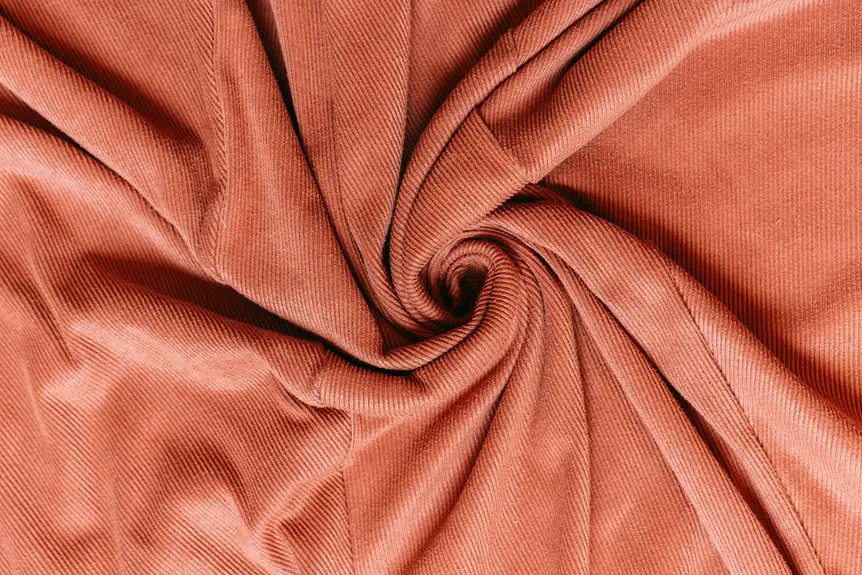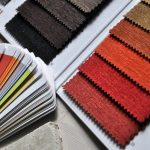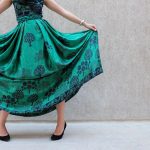Pinwale corduroy is a soft, durable fabric marked by narrow, closely spaced ribs called wales that give it a fine texture and subtle sheen. You’ll find it breathable and versatile, perfect for lightweight jackets, skirts, or kids’ clothing. Compared to widewale corduroy, it offers a refined, elegant look while remaining comfortable. When working with pinwale, careful cutting and gentle care keep it looking great. Keep going to explore sewing tips and upkeep advice to master this stylish fabric.
Table of Contents
Key Takeaways
- Pinwale corduroy features fine, narrow ribs that create a soft, smooth texture ideal for elegant, lightweight apparel designs.
- It is made from breathable cotton or blends, balancing durability with comfort for transitional season garments.
- Designers should cut with rib direction in mind and use sharp needles and longer stitches to prevent fabric damage.
- Pinwale offers a refined appearance with subtle sheen, distinct from the heavier, rugged widewale corduroy.
- Proper care involves washing inside out in cold water, air drying, and low-heat ironing on the reverse side to maintain texture.
What Is Pinwale Corduroy?
Pinwale corduroy stands out for its narrow, closely spaced ridges called wales. When you look at this fabric, you’ll notice these fine ribs give it a unique texture that’s both soft and durable.
Unlike wider wale corduroy, pinwale features more wales per inch, making it appear smoother and more refined. You’ll find it’s made from cotton or cotton blends, making it breathable yet sturdy enough for everyday wear.
Pinwale corduroy’s fine, closely spaced wales create a smooth, breathable fabric perfect for everyday wear.
If you’re a designer, pinwale corduroy offers a versatile option that balances comfort with style. You can use it for everything from shirts and dresses to lightweight jackets.
Its distinctive look allows you to create pieces that feel cozy without being bulky, perfect for changing seasons.
Characteristics of Pinwale Corduroy
You’ll notice pinwale corduroy stands out with its fine, narrow ribs that give it a smooth texture and sleek appearance.
It’s built to last, offering great durability and resistance to wear.
You’ll often find it in stylish clothing and upholstery thanks to these practical qualities.
Texture and Appearance
Fine ribs define corduroy’s unique texture, and pinwale corduroy takes this to a delicate extreme. When you work with pinwale corduroy, you’ll notice its fine, closely spaced ribs create a smooth, subtle surface.
This fabric’s appearance is refined and less bulky than wider wale versions, making it ideal for sleek, tailored designs. To help you understand its texture and look better, consider these points:
- Rib Density: Pinwale corduroy has more ribs per inch, giving it a softer feel and finer detail.
- Surface Sheen: The fabric often has a slight sheen, enhancing its elegant appeal.
- Color Depth: Its ribs catch light differently, producing rich color variations and a dynamic look.
These traits make pinwale corduroy perfect when you want a sophisticated yet tactile fabric.
Durability and Wear
Although it features delicate ribs, this type of corduroy holds up surprisingly well under regular wear. When you choose pinwale corduroy, you’re getting a fabric that balances softness with strength.
The fine ribs may look fragile, but they resist abrasion better than you might expect. You’ll notice that the fabric maintains its texture and color even after multiple washes, thanks to its tight weave.
However, keep in mind that because the ribs are narrower, they can be more prone to flattening if you don’t care for the fabric properly. To preserve its appearance, avoid harsh scrubbing or excessive friction.
With the right care, pinwale corduroy will remain durable, making it a reliable choice for pieces that need both style and longevity.
Common Uses
Pinwale corduroy’s distinctive narrow ribs make it a versatile fabric that suits a variety of clothing and accessories. When you choose pinwale corduroy, you’re picking a material that balances style and comfort perfectly.
Here are three common uses you should know:
- Apparel: Pinwale corduroy works great for lightweight jackets, skirts, and trousers, giving your designs a sleek textured look without bulk.
- Children’s Wear: Its softness and durability make it ideal for kids’ clothing, combining comfort with long-lasting wear.
- Accessories: You can also use it for bags, hats, and even cushion covers, adding subtle texture and warmth to everyday items.
Comparing Pinwale to Other Corduroy Types
When you compare pinwale to widewale corduroy, you’ll notice the texture differences right away.
You’ll also want to contemplate how durability varies between these types for your projects.
Finally, understanding their visual appeal helps you choose the best fabric for specific applications.
Pinwale vs. Widewale Texture
Texture plays a key role in distinguishing pinwale corduroy from its widewale counterpart.
When you compare the two, you’ll notice these key differences:
- Rib Width: Pinwale features very fine, narrow ribs, giving it a smooth, subtle texture, while widewale has much thicker ribs that create a bold, chunky appearance.
- Visual Impact: Pinwale’s delicate ribs lend a refined, elegant look suitable for lighter garments; widewale’s prominent ribs stand out more, adding rugged character.
- Feel: Pinwale feels softer and more pliable against the skin, offering comfort, whereas widewale’s texture is coarser and heavier.
Understanding these distinctions helps you choose the right corduroy type to match your design’s aesthetic and tactile goals.
Durability Differences Between Types
While the fine ribs of pinwale corduroy give it a sleek look and soft feel, they also impact how the fabric holds up over time. Pinwale corduroy tends to be less durable than widewale or standard wale types because its thinner ribs are more prone to wear and flattening. If you need long-lasting fabric for heavy use, wider wales might be a better choice. Here’s a quick durability comparison:
| Corduroy Type | Rib Width | Durability Level |
|---|---|---|
| Pinwale | Very fine (1-2mm) | Moderate |
| Standard Wale | Medium (3-5mm) | High |
| Widewale | Wide (6-8mm) | Very High |
Choose based on how much wear you expect the fabric to endure.
Visual Appeal and Applications
Many designers and wearers prefer pinwale corduroy for its delicate, refined look that sets it apart from wider wale varieties.
You’ll notice pinwale’s narrow ribs create a smoother texture and more sophisticated appearance, making it ideal for stylish clothing and upscale interiors.
When comparing pinwale to other corduroys, consider these points:
- Subtle Texture: Pinwale’s finer ribs offer a less bulky feel, perfect for tailored garments.
- Versatility: It works well in both casual and formal settings, unlike wider wale corduroy, which leans casual.
- Visual Elegance: The thin wale lines catch light softly, adding depth without overpowering the design.
Ideal Uses for Pinwale Corduroy in Design
Pinwale corduroy offers a unique combination of softness and durability that makes it perfect for a variety of design projects. You can use it for casual clothing like jackets, trousers, and skirts, where comfort and texture matter. Its fine ribs give garments a refined look without sacrificing warmth.
Beyond apparel, pinwale corduroy works well for upholstery, adding a cozy yet sophisticated touch to chairs and cushions. It’s also suitable for accessories such as bags and hats, where you want both style and resilience.
When designing for children’s wear, its softness guarantees comfort, while durability handles active use. Overall, pinwale corduroy fits projects that balance elegance with function, giving you versatile options to explore in your creative work.
Tips for Sewing and Handling Pinwale Corduroy
Because the fabric’s fine ribs run vertically, you’ll need to pay close attention to direction when cutting pinwale corduroy. Align your pattern pieces carefully to maintain the fabric’s texture and avoid mismatched ribs.
When sewing, use a sharp needle to prevent snagging and a longer stitch length for smoother seams.
Here are three tips to handle pinwale corduroy effectively:
- Press seams gently using a low heat setting and a pressing cloth to protect the ribs.
- Pin perpendicular to the ribs to keep fabric layers from shifting.
- Use a walking foot on your sewing machine to help feed the fabric evenly, reducing puckering.
Following these steps will help you achieve crisp, professional-looking results every time.
Caring for Pinwale Corduroy Garments and Items
Although corduroy’s fine ribs add texture and charm, they also demand careful care to keep your garments looking their best.
Corduroy’s distinctive ribs bring character but require gentle care to maintain their unique texture and appeal.
When washing pinwale corduroy, turn items inside out to protect the ribs and use cold water with a gentle cycle. Avoid harsh detergents and fabric softeners, which can damage the fabric’s texture.
Air drying is best—lay your garment flat or hang it to prevent crushing the ribs. If you need to iron, use a low heat setting and press on the reverse side with a cloth to avoid flattening the wale.
Spot clean stains promptly using a mild detergent and a soft brush, moving with the nap.
Frequently Asked Questions
Where Did Pinwale Corduroy Originate Historically?
You’ll find pinwale corduroy originated in 18th-century England, evolving from traditional corduroy. It gained popularity for its fine, narrow ribs, becoming a stylish yet durable fabric choice across Europe and later America.
What Are the Environmental Impacts of Producing Pinwale Corduroy?
You’ll find pinwale corduroy production uses significant water—about 2,700 liters per kilogram—due to cotton cultivation. This contributes to pollution and high energy use, so choosing sustainable sources can really help reduce these environmental impacts.
How Does Pinwale Corduroy Perform in Extreme Weather Conditions?
You’ll find pinwale corduroy offers moderate insulation but isn’t ideal for extreme cold or wet conditions. Its durability helps, but it can absorb moisture, so layering or waterproofing is essential when facing harsh weather.
Are There Sustainable Alternatives to Traditional Pinwale Corduroy?
You can choose sustainable alternatives like organic cotton pinwale corduroy or recycled polyester blends. These options reduce environmental impact while maintaining durability and texture, letting you create eco-friendly designs without sacrificing style or quality.
What Fashion Trends Have Popularized Pinwale Corduroy Over the Years?
Like a vintage record spinning back into style, pinwale corduroy’s popularity surged with ’70s retro revivals and ’90s grunge. You’ll see it in cozy jackets and trousers, blending nostalgia with modern streetwear effortlessly.
- Does Chiffon Fabric Stink - July 15, 2025
- Does Chiffon Fabric Affect the Economy - July 15, 2025
- Does Cotton Fabric Have a Nap - July 15, 2025







